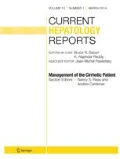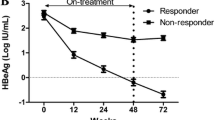Abstract
The expanding availability of different potent antiviral agents for the treatment of chronic hepatitis B (CHB) has created optimism for achieving treatment goals, such as the loss of serum hepatitis B surface antigen (HBsAg), which represents the closest-to-cure outcome of chronic hepatitis B virus infection. Recent studies indicated the potential usefulness of HBsAg quantification during antiviral therapy (especially with interferon-α-based regimens) as a potential predictor of virologic response. This article critically reviews the most recent data regarding the value of measurements of HBsAg concentrations in predicting response in patients with hepatitis B e antigen (HBeAg)-positive and HBeAg-negative CHB treated with different antiviral agents.
Similar content being viewed by others
References and Recommended Reading
European Association for the Study of the Liver: EASL Clinical Practice Guidelines: management of chronic hepatitis B. J Hepatol 2009, 50:227–242.
Lok AS, McMahon BJ: Chronic hepatitis B. Hepatology 2007, 45:507–539.
Fattovich G, Giustina G, Sanchez-Tapias J, et al.: Delayed clearance of serum HBsAg in compensated cirrhosis B: relation to interferon alpha therapy and disease prognosis. European Concerted Action on Viral Hepatitis (EUROHEP) [see comments]. Am J Gastroenterol 1998, 93:896–900.
Deguchi M, Yamashita N, Kagita M, et al.: Quantitation of hepatitis B surface antigen by an automated chemiluminescent microparticle immunoassay. J Virol Methods 2004, 115:217–222.
van Helden J, Denoyel G, Karwowska S, et al.: Performance of hepatitis B assays on the Bayer ADVIA Centaur Immunoassay System. Clin Lab 2004, 50:63–73.
Muhlbacher A, Weber B, Burgisser P, et al.: Multicenter study of a new fully automated HBsAg screening assay with enhanced sensitivity for the detection of HBV mutants. Med Microbiol Immunol 2008, 197:55–64.
Manesis EK, Hadziyannis ES, Angelopoulou OP, Hadziyannis SJ: Prediction of treatment-related HBsAg loss in HBeAG-negative chronic hepatitis B: a clue from serum HBsAg levels. Antivir Ther 2007, 12:73–82.
Moucari R, Mackiewicz V, Lada O, et al.: Early serum HBsAg drop: a strong predictor of sustained virological response to pegylated interferon alfa-2a in HBeAg-negative patients. Hepatology 2009, 49:1151–1157.
Brunetto MR, Moriconi F, Bonino F, et al.: Hepatitis B virus surface antigen levels: a guide to sustained response to peginterferon alfa-2a in HBeAg-negative chronic hepatitis B. Hepatology 2009, 49:1141–1150.
Perrillo RP: Hepatitis B surface antigen quantification as a current-day paradox: obtaining the gold in the face of diminishing returns. Hepatology 2009, 49:1063–1065.
Blumberg BS, Alter HJ, Visnich S: A “new” antigen in leukemia sera. JAMA 1965, 191:541–546.
Seeger C, Mason WS: Hepatitis B virus biology. Microbiol Mol Biol Rev 2000, 64:51–68.
Janssen HL, Kerhof-Los CJ, Heijtink RA, Schalm SW: Measurement of HBsAg to monitor hepatitis B viral replication in patients on alpha-interferon therapy. Antiviral Res 1994, 23:251–257.
Zoulim F, Mimms L, Floreani M, et al.: New assays for quantitative determination of viral markers in management of chronic hepatitis B virus infection. J Clin Microbiol 1992, 30:1111–1119.
Dandri M, Murray JM, Lutgehetmann M, et al.: Virion halflife in chronic hepatitis B infection is strongly correlated with levels of viremia. Hepatology 2008, 48:1079–1086.
Kohmoto M, Enomoto M, Tamori A, et al.: Quantitative detection of hepatitis B surface antigen by chemiluminescent microparticle immunoassay during lamivudine treatment of chronic hepatitis B virus carriers. J Med Virol 2005, 75:235–239.
Chan HL, Wong VW, Tse AM, et al.: Serum hepatitis B surface antigen quantitation can reflect hepatitis B virus in the liver and predict treatment response. Clin Gastroenterol Hepatol 2007, 5:1462–1468.
Werle-Lapostolle B, Bowden S, Locarnini S, et al.: Persistence of cccDNA during the natural history of chronic hepatitis B and decline during adefovir dipivoxil therapy. Gastroenterology 2004, 126:1750–1758.
Wursthorn K, Lutgehetmann M, Dandri M, et al.: Peginterferon alpha-2b plus adefovir induce strong cccDNA decline and HBsAg reduction in patients with chronic hepatitis B. Hepatology 2006, 44:675–684.
Borgniet O, Parvaz P, Bouix C, et al.: Clearance of serum HBsAg and anti-HBs seroconversion following antiviral therapy for chronic hepatitis B. J Med Virol 2009, 81:1336–1342.
Volz T, Lutgehetmann M, Wachtler P, et al.: Impaired intrahepatic hepatitis B virus productivity contributes to low viremia in most HBeAg-negative patients. Gastroenterology 2007, 133:843–852.
Jaroszewicz J, Calle Serrano B, Deterding K, et al.: HBsAg serum levels are associated with the phase of HBV-infection. J Hepatol 2009, 50(Suppl 1):S139.
Chen J, Wang Z, Guo Y, et al.: Serum HBsAg changes in HBeAg positive chronic hepatitis B patients with continuous viral load reductions during treatment with adefovir or peg-interferon-alpha-2a. Antiviral Res 2009, 81:88–91.
Wursthorn K, Jung M, Manns M, et al.: Kinetics of HBsAg decline in HBeAg+ chronic hepatitis B patients with 3 years of telbivudine treatment during the GLOBE study. J Hepatol 2009, 50(Suppl1):S9.
Lau GK, Marcellin P, Brunetto M et al.: On-treatment monitoring of HBsAg levels to predict response to peginterferon alfa-2a in patients with HBeAg-positive chronic hepatitis B. J Hepatol 2009, 50(Suppl 1):S333.
Takkenberg B, Zaajer H, Weegink C et al.: Baseline HBsAg level predict HBsAg loss in chronic hepatitis B patients treated with a combination of peginterferon alfa-2a and adefovir: an interim analysis. J Hepatol 2009, 50(Suppl 1):S8.
Author information
Authors and Affiliations
Corresponding author
Rights and permissions
About this article
Cite this article
Hadziyannis, E., Vassilopoulos, D. & Hadziyannis, S.J. Quantitative HBsAg titer as predictor of response to therapy. Curr hepatitis rep 8, 169–172 (2009). https://doi.org/10.1007/s11901-009-0024-8
Published:
Issue Date:
DOI: https://doi.org/10.1007/s11901-009-0024-8




